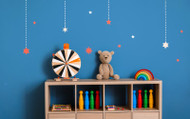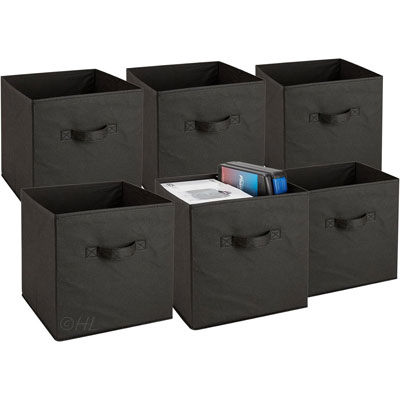We are often responsible for setting up an environment that will facilitate healthy development for children as parents, caregivers, or educators. From healthy nutrition to emotional nourishment, everything we do or decide has the potential to influence our growth. One area where people rarely reflect on its contribution to child development is how toys are stored and organized. Specifically, rotational toy storage—where a selection of toys is rotated periodically—has emerged as a concept that can significantly enhance a child's development.
A toy system with a rotational element is straightforward in its functionality. However, rotational toy storage strongly influences numerous facets of child development, including cognitive, emotional, and physical growth. In the blog, we'll discuss this system and see how it can be used to nurture your child.
Organize your child's toys effortlessly with Handy Laundry's stylish and durable storage cube bins – shop now and create a clutter-free, creative play space!
What Is Rotational Toy Storage?
Rotational toy storage is an application in which all the child's toys are organized into groups and then rotated regularly. Rather than all the toys being present at a given time, only some are kept available, and the rest are kept in storage for that duration. After several weeks or months, the toys sent to storage are switched out for those in circulation.
This system can renew the child's fascination and interest in using the toys playfully. Rotational storage allows the same existing toys to gain maximum utility, limiting clutter and providing an orderly and peaceful setup.
Role Of Rational Toy Storage In Child Development
Rotational toy storage is a simple yet effective strategy to enhance a child’s development by promoting focus, creativity, and emotional growth. By rotating toys regularly, children can engage more deeply with their play, fostering cognitive, social, and physical skills.
1. Cognitive Development
Developing cognitive abilities is among the major parts of a child's learning. Their cognitive skills have to do with memory, critical thinking, and fixation on activities to be done.
Too many toys can overwhelm a child and make it hard for them to play focused. Rotatingtoy storage reduces distractions, which enables children to concentrate better. Children with fewer choices will focus on one toy or activity for a longer period, promoting critical thinking and problem-solving.
In addition, rotation creates variety. When little ones are exposed to new toys or mixtures after a while, they first treat them with curiosity and eagerness. This stimulates exploration, boosting learning and developing cognitive skills, such as spatial reasoning, cause and effect, and creativity.
2. Emotional and Social Development
Rotational toy storage also fosters emotional and social development. When children play with a few toys, they develop an attachment to them, which makes them feel comfortable and secure. This attachment can lead to emotional strength and well-being.
Moreover, limited access to toys promotes flexibility. Children learn to be flexible as they experience new toys through rotations, which helps them develop emotional strength by embracing new experiences.
From a social perspective, rotational toy storage encourages sharing and collaboration. Since fewer toys are available, children are likelier to interact with others and share what they have. This is especially helpful in group settings, such as playdates or preschool, where social skills like sharing, taking turns, and cooperation are crucial.
Additionally, rotational toys help minimize the occurrence of possessiveness. Children are likely to spend playtime taking turns and being friendly with each other because fewer toys limit the number of toys with each child.
3. Physical Development
Rotational toy storage also enhances physical development by showing children different toys promoting physical activity. For instance, building blocks, puzzles, or art supplies improve fine motor skills, but outdoor toys such as bikes or balls foster gross motor activities.
Parents can ensure that their child develops both fine and gross motor skills by rotating the toys. A rotation may contain toys that require physical movement, such as climbing structures, while another may contain creative toys that develop dexterity, like stacking blocks or drawing tools.
Second, organized playtime helps the children play without boredom, allowing them to involve themselves in more physically engaging play and improve their equilibrium, coordination, and muscularity.
4. Lowering Over-Stimulation
A fast world bombards a lot of stimulation within children; overstimulation makes them fail to concentrate on specific playthings, while overestimation causes unexcitement toward playing time.
Rotational toy storage eliminates this problem. Reducing choices available at once also removes the overwhelmingness of having excessive toys. Therefore, they'll be able to be more focused on meaningful play instead of being overwhelmed, thus ending up with more satisfying play activities.
A tidy, organized play area created through rotational toy storage also promotes a sense of calm and order. Children can focus better on each activity and engage more deeply with their toys.
How To Implement Rotational Toy Storage
Implementing a rotational toy storage system can be simple and effective with just a few basic steps. Here’s how to get started:
Sort and Categorize: Start with categorizing your child's toys based on type, age appropriateness, and interest. This can be puzzles, building toys, dolls, art supplies, or outdoor toys.
Choose Rotation Frequency: Decide how often you want to rotate the toys. Some parents prefer to rotate them weekly, while others may do so monthly. The goal is to create enough time for the child to engage deeply with the toys without becoming bored.
Store the Toys: Store the toys in bins or boxes in a place easily accessible when it's time for a rotation.
Introduce New Toys Gradually: When it's time for a rotation, introduce a new selection of toys to keep the experience fresh.
Observe and Adapt: Monitor your child's engagement with the toys and adjust occasionally. You can realize that particular toys should be rotated more than others and recognize certain combinations that evoke more creativity.
Conclusion
Rotational storage of toys benefits kids in multiple ways, unlike merely storing things together. It enables them to develop in various domains: cognitive, emotional, social, and even physical development. Limiting the number of toys available at any given time allows children to focus more deeply, engage in imaginative play, and develop important life skills such as creativity, problem-solving, sharing, and collaboration. Additionally, rotational toy storage helps reduce overstimulation and clutter, creating a more peaceful and balanced play environment.
You will see your child thriving and growing up in a developmental nurturing space that encourages exploration, learning, and fun by implementing a rotational toy system in your home.
Frequently Asked Questions
How often should I rotate my child's toys?
It depends on the age and interests of the child. Toys are usually rotated once a week or bi-weekly, but the schedule can be adjusted according to the child's interest in his or her present toys.
What types of toys should I include in the rotation?
It is recommended that you have various toys that encourage different developmental needs, such as puzzles for problem-solving, building blocks for creativity, and other toys that help children develop physical movement for their motor skills.
Can I rotate toys for multiple children?
Yes, rotational toy storage can accommodate multiple children as long as the age-appropriate toys for each child are determined and rotated based on their preferences and developmental needs.



